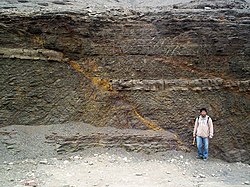Morro Solar Group
| Morro Solar Group | |
|---|---|
| Stratigraphic range: Berriasian-Hauterivian | |
 The seaward tilting of the strata of Salto del Fraile Fm. was caused by the Andean orogeny | |
| Type | Geological group |
| Location | |
| Region | Lima Province |
| Country | |
| Type section | |
| Named for | Morro Solar |
The Morro Solar Group (Spanish: Grupo Morro Solar) is a stratigraphic group of Mesozoic-aged sedimentary formations exposed near Lima, Peru. The groups formations more specifically of Berriasian and Valanginian age (Early Cretaceous) and overlies the Jurassic Puente Piedra Group and underlies the Cretaceous Pamplona Formation. The Morro Solar Group is intruded by sills of andesitic composition.[1] Together with the Casma and Imperial Groups, the Morro Solar Group contains clastic volcanosedimentary material derivative of the Mesozoic Casma Volcanic Arc.[2] The formations of the group hosts mostly local fossils which do not have counterparts for biochronological correlation in other regions.[3]
Stratigraphy
[edit]
The formations of the Morro Solar Group are: La Herradura Formation (Spanish: Formación La Herradura), whose sediments reflect a marine near-shore deposition environment,[4] the Valanginian Salto del Fraile Formation (Spanish: Formación Salto del Fraile), and the Marcavilca Formation (Spanish: Formación Marcavilca).[1] The Salto del Fraile Formation is equivalent to the basal part of the Huancané Formation found further inland.[5]
References
[edit]- ^ a b Ayala, Luis; Cuipa, Edward; Rossello, Carlos; López, Wilson; Llamoca, Paola; Gutiérrez, Nataly; Mendoza, Rossella. "Cartografiado e interpretación estructural del sector norte del Morro Solar, dpto. de Lima, Perú" (in Spanish). Retrieved 5 January 2016.
{{cite journal}}: Cite journal requires|journal=(help) - ^ Pfiffner, Adrian O.; Gonzalez, Laura (2013). "Mesozoic–Cenozoic Evolution of the Western Margin of South America: Case Study of the Peruvian Andes". Geosciences. 3 (2): 262–310. Bibcode:2013Geosc...3..262P. CiteSeerX 10.1.1.361.3591. doi:10.3390/geosciences3020262.
- ^ Cardozo, M.; Wauschkuhn, A. (1984). "The Copara and the Patap Metallotect on the Western Side of Central Peru". In Wauschkuhn, A.; Kluth, C.; Zimmermann, R.A. (eds.). Syngenesis and Epigenesis in the Formation of Mineral Deposits. Springer-Verlag. p. 619.
- ^ Cardozo, M. (1990). "The Copara Metallotect in Central Peru: Geologic Evolution and Ore Formation". In Fontboté, L.; Amstutz, G.C.; Cardozo, M.; Cedillo, E.; Frustos, J. (eds.). Stratabound Ore Deposits in the Andes. Springer-Verlag. p. 399.
- ^ Carlotto, Víctor; Cárdenas, José; Chávez, Richard; Gil, Willy (1995). "Sedimentología de la Formación Huancané (Neocomiano) de la región de Cusco y su relación con las variaciones del nivel del mar" (PDF). Bulletin de l'Institut français d'études andines (in Spanish). 24 (1): 1–21. doi:10.3406/bifea.1995.1170. S2CID 173729325. Retrieved 30 December 2015.

